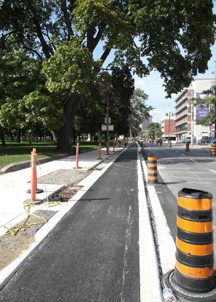By Eric Morse –

The almost-completed separated cycle path on Sherbourne St at Gerrard. The rounded mountable kerb is in the far background. The squared kerb begins at the accessible bus stop (rectanglar gravel patch in the left centre of the photo).
Representatives from the city’s transportation services office hosted a public meeting at Trinity College on Sept. 11 to consult with stakeholders on proposed design variations for the projected Wellesley–Hoskin–Harbord bicycle lanes.
The meeting followed up on the initial public consultation from June 27, which was based on a council decision of July 2011 ordering detailed design and consultation to construct separated bicycle lanes in 2012.
The original area for this project was to be between Sherbourne St. in the east and Queen’s Park in the west. In 2012 it was extended eastward to Parliament St. and west to St. George.
The June consultation identified a few areas of specific concern including the preservation of left turns where they now exist, and issues with loading/unloading access for businesses along the route.
Surprisingly, on-street parking did not emerge as a major concern from the June meeting. Daniel Egan, manager of the cycling infrastructure program for the city noted that the installation of cycle lanes will cost about 40 on-street slots on Wellesley, but these have been made up by the expansion of side-street parking locations by about the same amount.
Queen’s Park Circle provides the trickiest challenge along the proposed route. The solution the city unveiled on Sept 11 envisages a separate two-way cycle lane around the inside of the circle (the park side) with a couple of possible crosswalk variations at the junction with Hoskins Ave. One desired outcome is to decrease cycle traffic on the paths in Queen’s Park itself.
The Sept. 11 open house provided assorted possible design features for one and two-way cycle lanes, with combinations of mountable kerbs, concrete kerbs, plastic bollards, thermoplastic road markings at intersections and other points where cycle traffic mixes with pedestrians and vehicles, and accessible bus stops.
The city is consulting with businesses and residents along the proposed route, as well as with cyclists and pedestrians. Proposals based on public input from the Sept. 11 meeting will go to the public works and infrastructure committee in November.
An initial phase of retrofit along Wellesley is scheduled for 2013 with a full reconstruction coordinated with the capital reconstruction of Wellesley St in 2014. When complete, it will furnish an east-west axis to complement the north-south corridor now being built on Sherbourne St. between Bloor and King streets, which is due to be finished in November.
Patrick Egan, a cyclist resident in the Bay/College neighbourhood, thinks that a physically separated cycle lane along Wellesley will greatly increase both real and perceived safety for cyclists.
“I like where the city’s going,” Jared Kolb, an executive member of stakeholder group Cycle Toronto, told The Bulletin. “It’s a measured approach to separate bike lanes. It proposes a full reconstruction of Wellesley, a separated-track design to coincide with major street work in 2014—which is wise—and a bi-directional path around Queen’s Park, which I think is the right way to go on that. I think that’s great for cyclists and for people who love parks. The consultation process has been good and there have been lots of chances for public feedback.”
For information and updates, visit www.toronto.ca/cycling/wellesley.
 TheBulletin.ca Journal of Downtown Toronto
TheBulletin.ca Journal of Downtown Toronto

